Semiology of Art and Mysticism in Persian Architecture According to Rumi’s Mystical Opinions (Case Study: Sheikh Lotf-Allah Mosque, Iran)
Abstract
1. Introduction
- What influence has Rumi’s mysticism had on the formation of the physical elements of Persian architecture?
- What influence will the use of Rumi’s mysticism have on the nature of the architectural space of the Sheikh Lotf-Allah Mosque?
2. Theoretical Framework
2.1. Semiology of Art and Mysticism
2.2. Rumi’s Mysticism
2.3. Mysticism in Islamic Architecture
2.4. Representation of Mysticism in the Body of Islamic Architecture
2.5. Rumi’s Expression of Architecture
3. Research Methodology
3.1. Case Study
3.2. Research Design and Procedures
4. Research Findings
4.1. Geometric Analysis of the Sheikh Lotf-Allah Mosque to Create Unity in the Spatial Order
4.2. Analysis of Equilibrium for Creation of Unity in the Materialistic Order
4.3. Illumination Analysis of the Sheikh Lotf-Allah Mosque to Create Unity in Visual Order
4.4. Semiology of Arrays Implemented in the Sheikh Lotf-Allah Mosque
4.5. Manifestation of Mysticism in the Sheikh Lotf-Allah Mosque
5. Discussion
5.1. The Obtained Interpretations of the Research Findings
5.2. Research Contribution
6. Conclusions
Author Contributions
Funding
Institutional Review Board Statement
Informed Consent Statement
Data Availability Statement
Conflicts of Interest
References
- Abdolhakim, Khalife. 1997. Mysticism of Rumi. Tehran: Cultural Science. [Google Scholar]
- Akkach, Samer. 2012. Cosmology and Architecture in Premodern Islam: An Architectural Reading of Mystical Ideas. New York: State University of New York Press. [Google Scholar]
- Alitajer, Saeid, and Ghazaleh Molavi Nojoumi. 2016. Privacy at home: Analysis of behavioral patterns in the spatial configuration of traditional and modern houses in the city of Hamedan based on the notion of space syntax. Frontiers of Architectural Research 5: 341–52. [Google Scholar] [CrossRef]
- Ardalan, Nader. 1995. Iranian Architecture in the Speech of Four Generations of Expert Architects. Abadi Quarterly 5: 4–45. [Google Scholar]
- Ardalan, Nader, and Laleh Bakhtiar. 2000. The Sense of Unity: The Sufi Tradition in Persian Architecture. New York: Kazi Publications. [Google Scholar]
- Askarizad, Reza. 2020. Evaluation of the Effective Factors on Social Interactions in the Design of Public Libraries. Tehnički Glasnik 14: 403–10. [Google Scholar] [CrossRef]
- Askarizad, Reza, and Hossein Safari. 2018. Confrontation of the basic concepts of Islamic mysticism and post-structuralism philosophy in architecture with emphasizing on Rumi and Jacques Derrida’s Views. Herald NAMSCA 4: 399–405. [Google Scholar]
- Baboldashti, Mahgol Seirafian, Seyedeh Marzieh Tabaeian, and Ahmadreza Shirvani Dastgerdi. 2018. The influence of natural ideas in promoting genius loci (Case study of Sheikh Lotfollah Mosque in Isfahan). Journal of Islamic Architecture 5: 53–60. [Google Scholar] [CrossRef]
- Blair, Sheila S., and Jonathan M. Bloom. 1994. The Art and Architecture of Islam, 1250–1800. London: Yale University Press. [Google Scholar]
- Bolandian, Mohammadmehdi, and Sara Naseri. 2014. Re-reading the symbolic concepts of Islamic mysticism in narrative texts and its reflection in the body and spatial-ossification of the city. Urban Management 13: 281–304. [Google Scholar]
- Braginsky, Vladimir. 1993. Universe-Man-Text: The Sufi Concept of Literature. Bijdragen tot de Taal-, Land- en Volkenkunde 149: 201–25. [Google Scholar] [CrossRef]
- Brend, Barbara. 1991. Islamic Art. Cambridge: Harvard University Press. [Google Scholar]
- Burckhardt, Titus. 1967. Sacred Art in East and West: Its Principles and Methods. Rajasthan: Airlift. [Google Scholar]
- Burckhardt, Titus. 2009. Art of Islam: Language and Meaning. Bloomington: World Wisdom. [Google Scholar]
- Ching, Francis D. K. 2007. Architecture: Form, Space, and Order, 3rd ed. New York: John Wiley & Sons. [Google Scholar]
- Chittick, William C. 2005. The Sufi Doctrine of Rumi (Spiritual Masters). New York: World Wisdom. [Google Scholar]
- Dabbour, Loai M. 2012. Geometric proportions: The underlying structure of design process for Islamic geometric patterns. Frontiers of Architectural Research 1: 380–91. [Google Scholar] [CrossRef]
- Dickson, William Rory. 2022. Sufism and Shari‘a: Contextualizing Contemporary Sufi Expressions. Religion 13: 449. [Google Scholar] [CrossRef]
- Esmi, Amir, and Hamidreza Saremi. 2014. Mysticism and its impact on Safavid dynasty architecture (Mosque of Sheikh Lotfollah in Isfahan). Research Journal of Environmental and Earth Sciences 6: 333–39. [Google Scholar] [CrossRef]
- Farrag, Engy. 2017. Architecture of mosques and Islamic centers in Non-Muslim context. Alexandria Engineering Journal 56: 613–20. [Google Scholar] [CrossRef]
- Ghouchani, Mahya, and Mohammad Taji. 2021. Promoting spirituality in the architectural thought of the mosque: A sense of place approach. Journal of Islamic Architecture 6: 151–159. [Google Scholar] [CrossRef]
- Ghoyoumi, Mehrdad, and Hamidreza Pishvaei. 2012. The relationship between place and human in Masnavi. Molana Pajouhi Journal 4: 87–105. [Google Scholar]
- Haj Vaziri, Alireza, Parnaz Goodarzparvari, and Ismail Baniardalan. 2021. Comparative body analysis of sheikh lotfollah mosque in Isfahan and Ahmed mosque in Istanbul. Journal of Islamic Architecture 6: 132–42. [Google Scholar] [CrossRef]
- Hillenbrand, Robert. 1994. Islamic Architecture: Form, Function and Meaning. Edinburgh: Edinburgh University Press. [Google Scholar]
- Hillenbrand, Robert. 1999. Islamic Art and Architecture. London: Thames and Hudson. [Google Scholar]
- Hillenbrand, Robert. 2003. Studying Islamic architecture: Challenges and perspectives. Architectural History 46: 1–18. [Google Scholar] [CrossRef]
- Hoffman, Douglas R. 2010. Seeking the Sacred in Contemporary Religious Architecture. Kent: Kent State University Press. [Google Scholar]
- Iosa, Marco, Giovanni Morone, and Stefano Paolucci. 2018. Phi in physiology, psychology and biomechanics: The golden ratio between myth and science. Biosystems 165: 31–39. [Google Scholar] [CrossRef]
- Jones, Richard H. 2022. Secular Mysticism. Religions 13: 650. [Google Scholar] [CrossRef]
- Karimi, Somayeh, Parnaz Goodarzparvari, Mohammad Aref, and Pardis Bahmani. 2020. A comparative study of the geometric motifs of the Ateeq mosque (Shiraz) and the Cordoba mosque (Cordoba) with a contextual approach. Journal of Islamic Architecture 6: 93–102. [Google Scholar] [CrossRef]
- Kazemi, Mehrvash, Vahdat Parisa Ghasemi, and Armin Alizadeh. 2012. Sema and Its Related Spaces Effects on Framework, Architectural and Urban Spaces of Chalapioghlu Khangah (Zanjan, Iran). International Journal of Architecture and Urban Development 2: 63–72. [Google Scholar]
- Khotbehsara, Elham Mehrinejad, Reza Askarizad, Maryam Mehrinejad, Sara Nourmusavi Nasab, and Kathirgamalingam Somasundaraswaran. 2022. The impact of COVID-19 on visitors’ wayfinding within healthcare centers. Ain Shams Engineering Journal, 101957. [Google Scholar] [CrossRef]
- Khozaei Ravari, Fatemeh, Ahmad Sanusi Hassan, Muhammad Hafeez Abdul Nasir, and Mohsen Mohammad Taheri. 2022. The development of residential spatial configuration for visual privacy in Iranian dwellings, a space syntax approach. International Journal of Building Pathology and Adaptation, 1–32. [Google Scholar] [CrossRef]
- Kiessel, Marko, and Asu Tozan. 2021. Mosque Architecture in Cyprus—Visible and Invisible Aspects of Form and Space, 19th to 21st Centuries. Religions 12: 1055. [Google Scholar] [CrossRef]
- Leopold, Cornelie. 2006. Geometry Concepts in Architectural Design. Paper presented at the 12th International Conference on Geometry and Graphics, Salvador, Brazil, August 6–10. [Google Scholar]
- Lipaee, Sindokht Rezaei, Hossein Soltanzadeh, and Reza Askarizad. 2020. Analysis of Arthur Upham Pope’s Viewpoint in Relation to the Persian Architecture A Systematic Review on the Book Entitled “A Survey of Persian Art”. Journal of Art and Civilization of the Orient 8: 15–24. [Google Scholar]
- Matracchi, Pietro, and Ali Sadeghi Habibabad. 2021. Explaining and evaluating the quality of “light” in religious environments and its effect on spirituality. Frontiers of Architectural Research 10: 803–20. [Google Scholar] [CrossRef]
- Matracchi, Pietro, and Ali Sadeghi Habibabad. 2022. Prioritizing the effect of “Light” in the religious places and environments with an emphasis on the sense of spirituality. Ain Shams Engineering Journal 13: 101514. [Google Scholar] [CrossRef]
- Memarian, Gholamhossein. 2005. An Introduction to the Theoretical Fundamentals of Architecture. Tehran: Soroush Danesh. [Google Scholar]
- Mirmiran, Hadi. 1996. What can be learned from the architecture of the past. Abadi Quarterly 6: 29–36. [Google Scholar]
- Mirzakhanian, Maryam, and Fatemeh Shahroudi. 2014. The wisdom of numbers in the decoration and structure of Sheikh Lotf-Allah Mosque, relying on the letters of the alphabet. Naghsh Mayeh 20: 33–38. [Google Scholar]
- Moghadam, Cyrus R., and Reza Askarizad. 2019. English for Architecture Students. Rasht: Kadusan. [Google Scholar]
- Mustafa, Faris Ali, and Saya Jamal Rashid. 2019. Studying the Human Scale and Proportionality of Mosque Buildings: Some Selected Case Studies in Erbil City. Journal of Islamic Architecture 5: 129–36. [Google Scholar] [CrossRef]
- Nabavi, Faezeh, and Yahaya Ahmad. 2016. Is there any geometrical golden ratio in traditional Iranian courtyard houses? International Journal of Architectural Research Archnet-IJAR 10: 143–54. [Google Scholar] [CrossRef]
- Naseri, Hosein, and Zahra Amini Farsani. 2022. An investigation into geometric ratios of the sunken courtyards in traditional Iranian houses (A field study on Yazd and Kashan). Journal of Architecture and Urbanism 46: 58–67. [Google Scholar] [CrossRef]
- Nasr, Seyyed Hossein. 2007. The Essential Seyyed Hossein Nasr. Bloomington: World Wisdom. [Google Scholar]
- Necipoglu, Gulru. 1996. Geometry and Ornament in Islamic Architecture. Oxford: Oxford University Press. [Google Scholar]
- NikKhah, Mohammad, Faezeh Miralami, and Zahra Poursafar. 2021. Route analysis in the architecture of museums and tomb buildings through space syntax case study: (Tomb of Nader Shah in Mashhad, Avicenna Mausoleum in Hamadan, and Mausoleum of poets in Tabriz). Journal of Asian Architecture and Building Engineering 20: 640–49. [Google Scholar] [CrossRef]
- Parsaee, Mojtaba, Mohammad Parva, and Bagher Karimi. 2015. Space and place concepts analysis based on semiology approach in residential architecture. HBRC Journal 11: 368–83. [Google Scholar] [CrossRef]
- Pazoki, Shahram. 2003. An introduction to the mystical principles of art and beauty in Islam with reference to the spiritual Masnavi. Honar-Ha-ye-Ziba 15: 4–13. [Google Scholar]
- Petersen, Andrew. 1999. Dictionary of Islamic Architecture. New York: Routledge. [Google Scholar]
- Pishvaei, Hamidreza. 2011. Skies and Heavens in the Spiritual Masnavi: A Study of the Architectural Levels in Relation to Universe and Human. Master’s thesis, Iranian Architectural Studies, Shahid Beheshti University, Faculty of Architecture and Urban Planning, Tehran, Iran. [Google Scholar]
- Pishvaei, Hamidreza, and Mehrdad Ghoyoumi. 2013. Soil and Wisdom: A reflection on the dignity of architecture in the spiritual Masnavi. Iranian Architectural Studies 3: 17–35. [Google Scholar]
- Rabbat, Nasser. 2014. ‘Islamic Architecture’ and the Profession. International Journal of Islamic Architecture 3: 37–40. [Google Scholar] [CrossRef]
- Rahmani, Mehrdad, and Behnaz Aminzadeh. 2017. Sustainable (ethical) Dialogue in Urban Planning based on Molana and Bakhtin Approaches to Dialogue. Journal of Social Theories of Muslim Thinkers 7: 33–54. [Google Scholar]
- Rahnavard, Zahra. 1995. An Introduction to the Wisdom of Islamic Art. Journal of Fine Arts 4: 22–32. [Google Scholar]
- Rehman, Abdul. 2002. Abdul Rehman: The Grand Tradition of Islamic Architecture. Edited by Gulzar Haider. Understanding Islamic Architecture. London: Routledge, p. 4. [Google Scholar]
- Ruck, Nancy, Øyvind Aschehoug, Sirri Aydinli, Jens Christoffersen, Gilles Courret, Ian Edmonds, and Stephen Selkowitz. 2000. Daylight in Buildings: A Source Book on Daylighting Systems and Components; Berkeley: Lawrence Berkeley National Laboratory.
- Rumi, Maulana Jalaluddin Mohammad. 2009. The Mesnevi. South Carolina: BiblioLife. [Google Scholar]
- Rumi, Maulana Jalaluddin Mohammad. 2021. Fihe Ma Fih—Bilingual Selected Teachings of Rumi: Jalal ad-Din Muhammad Rumi. Translated by Farzaneh Farshad. Tehran: Independently published. [Google Scholar]
- Saniei, Mandana, and Ali Delavar. 2012. Communicational Role of Mosques Architecture. Asian Social Science 8: 137–41. [Google Scholar] [CrossRef]
- Schimmel, Annemarie. 1993. The Triumphal Sun: A Study of the Works of Jalaloddin Rumi. New York: State University of New York Press. [Google Scholar]
- Shahani, Mohammadhossein. 2018. Sheikh Lotfollah Mosque: A Story of Daylight in Sequential Spaces. Space and Culture 24: 1–18. [Google Scholar] [CrossRef]
- Shahshahani, Soheila. 1998. Esfahan’s gardens and mosques: On the instrumentality of symbols as a means of retaining urban identity. Digest of Middle East Studies (DOMES) 22: 602–13. [Google Scholar] [CrossRef]
- Soleymani, Roomina Ardejani, and Reza Askarizad. 2018. Semiology of Semantic Components in Iranian Gardens Case Study: Eram and Narenjestan Gardens in Shiraz. Creative City Design 1: 42–52. [Google Scholar]
- Zarrabi-Zadeh, Saeed. 2008. Defining mysticism, a survey of main definitions. Transcendent Philosophy 9: 77–92. [Google Scholar]
- Zarrabi-Zadeh, Saeed. 2016. Practical Mysticism in Islam and Christianity: A Comparative Study of Jalal al-Din Rumi and Meister Eckhart. London: Routledge. [Google Scholar]
- Zolfagharkhani, Mina, and Michael J. Ostwald. 2021. The Spatial Structure of Yazd Courtyard Houses: A Space Syntax Analysis of the Topological Characteristics of the Courtyard. Buildings 11: 262. [Google Scholar] [CrossRef]



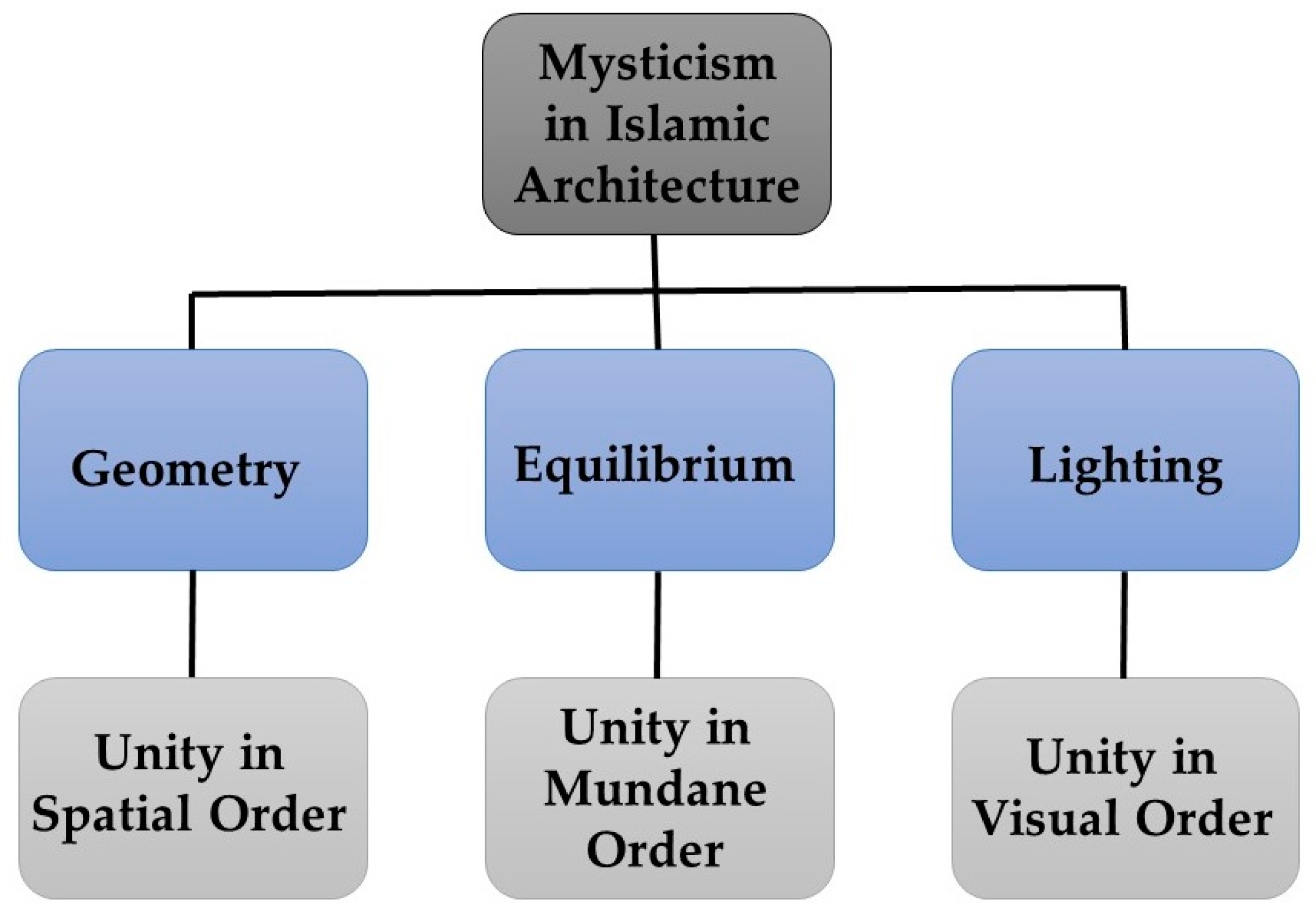
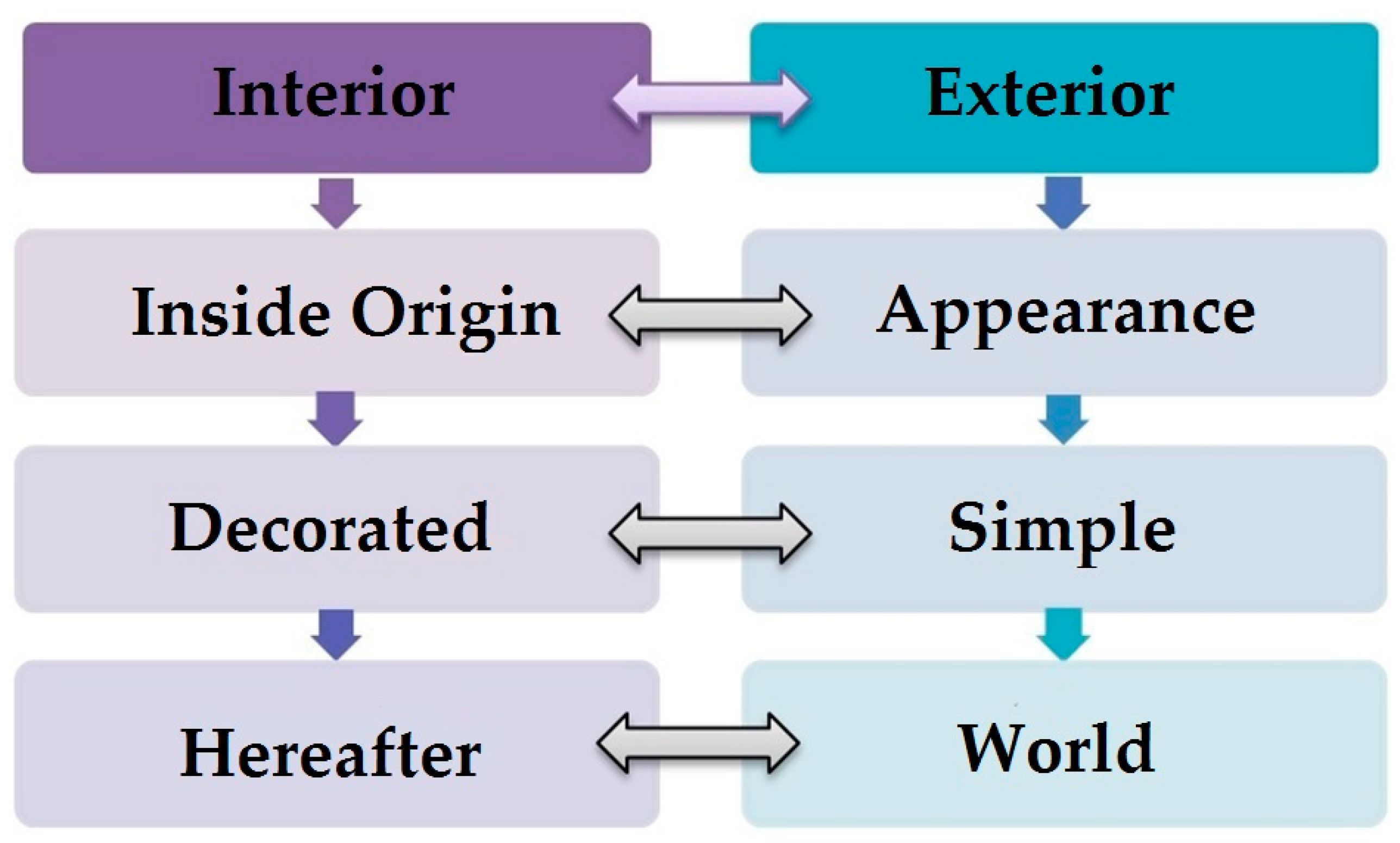
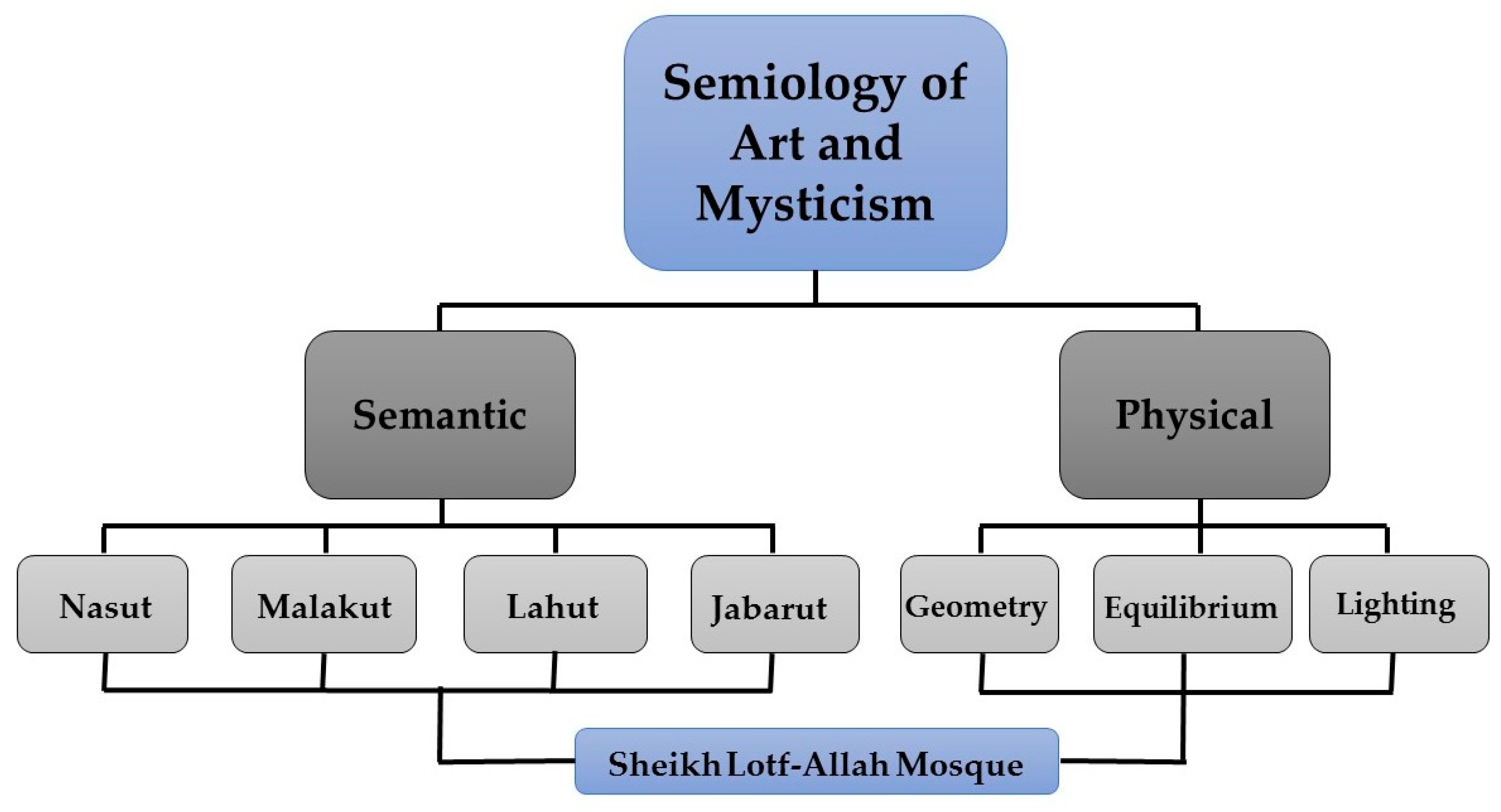


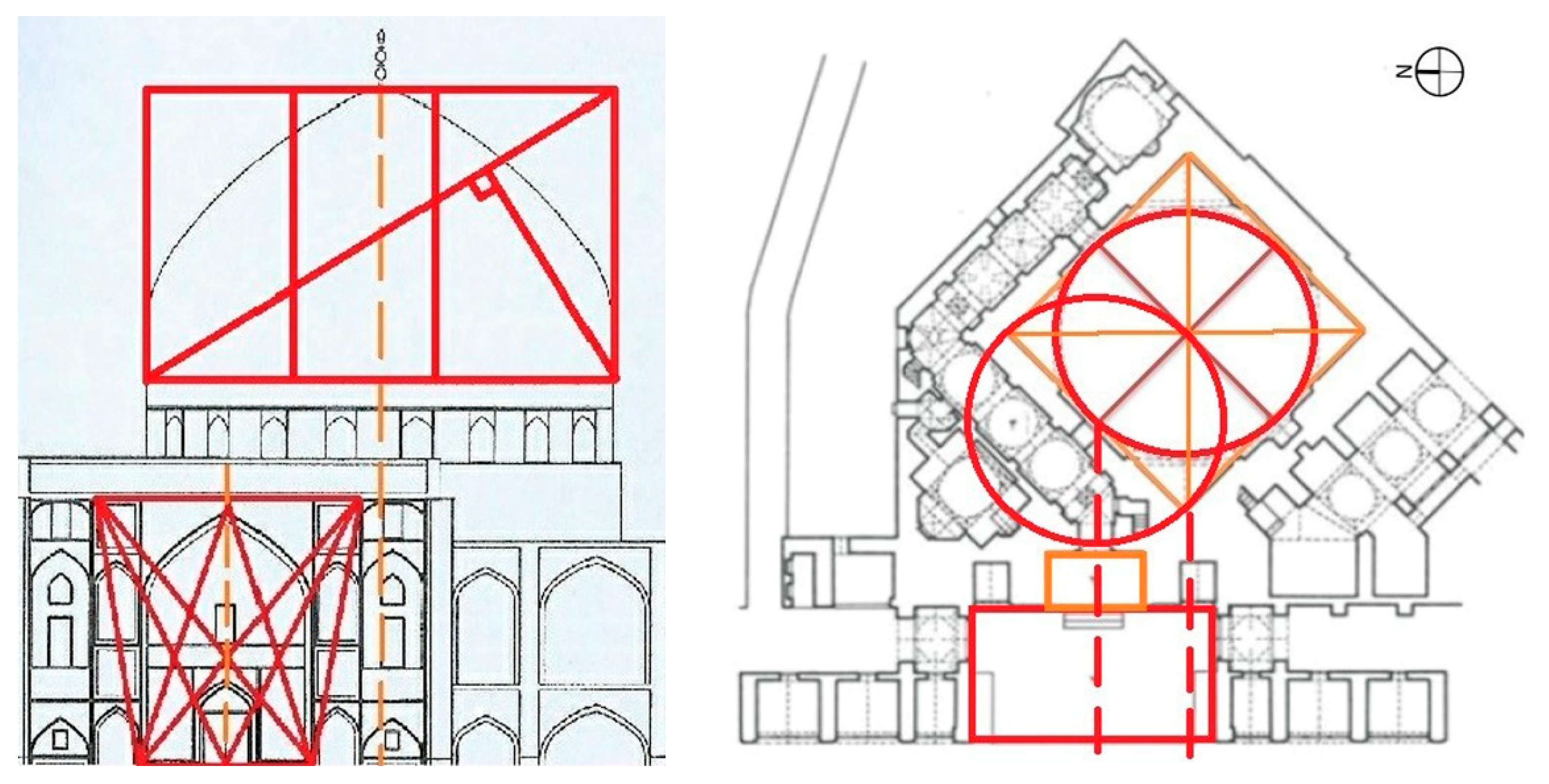
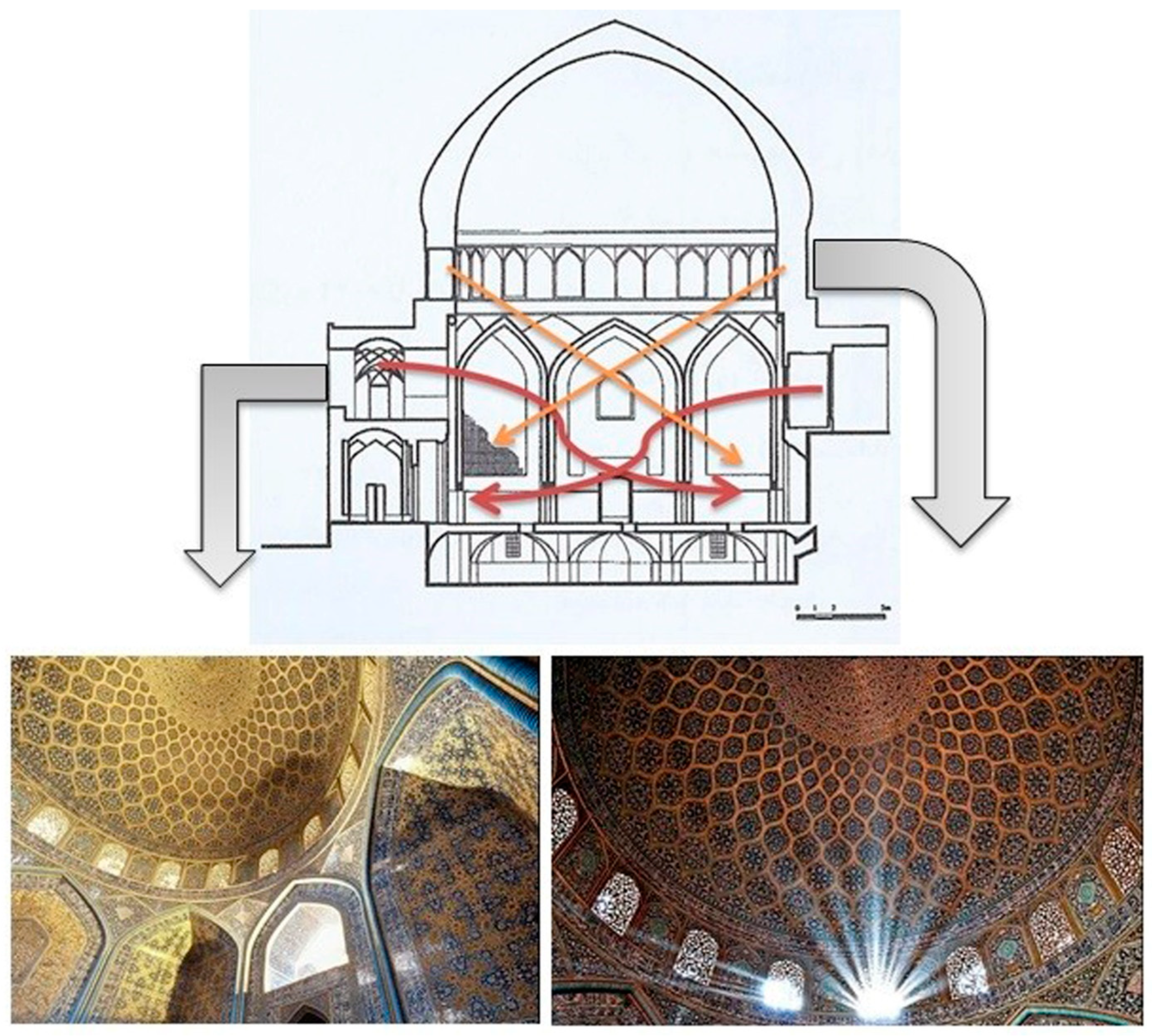

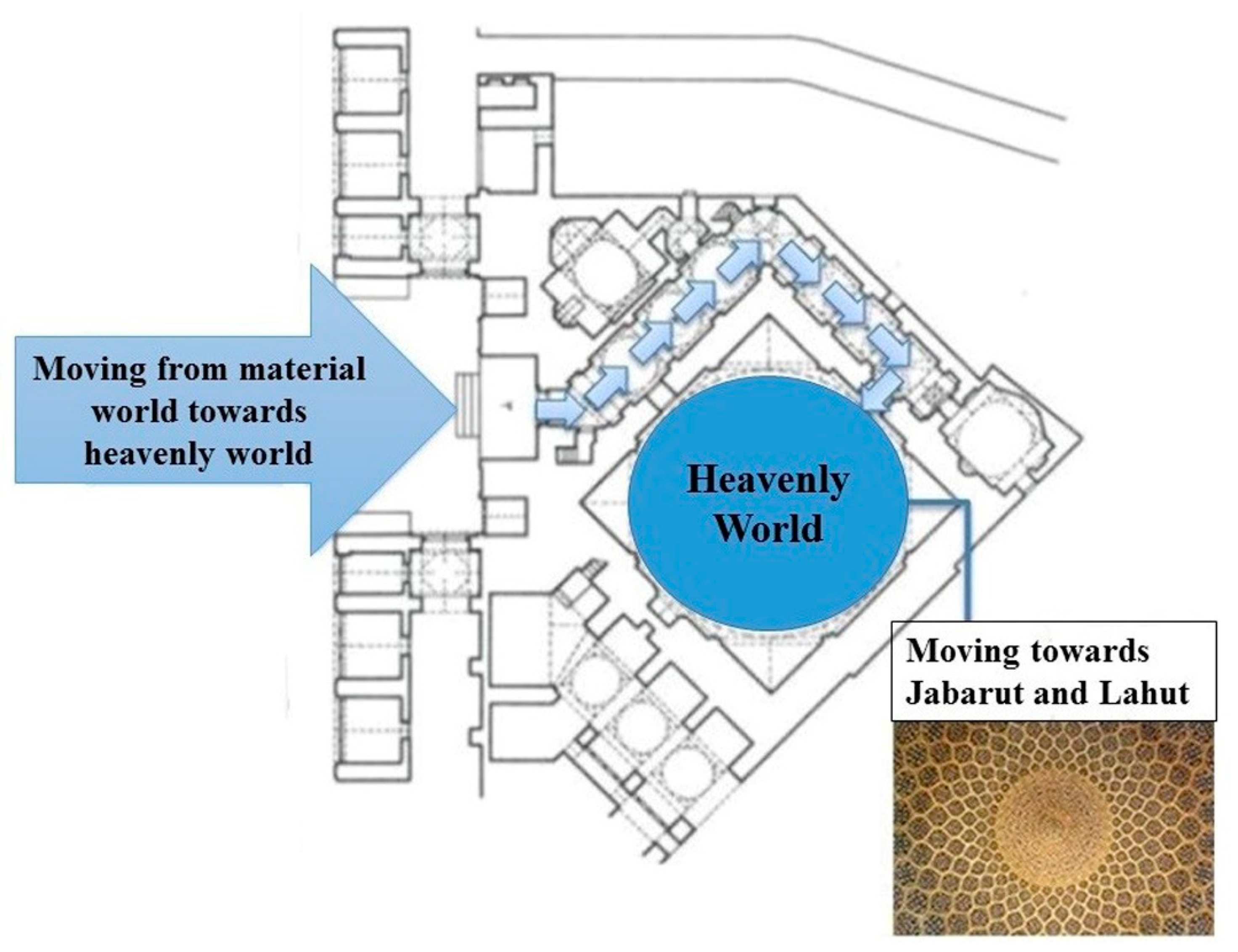
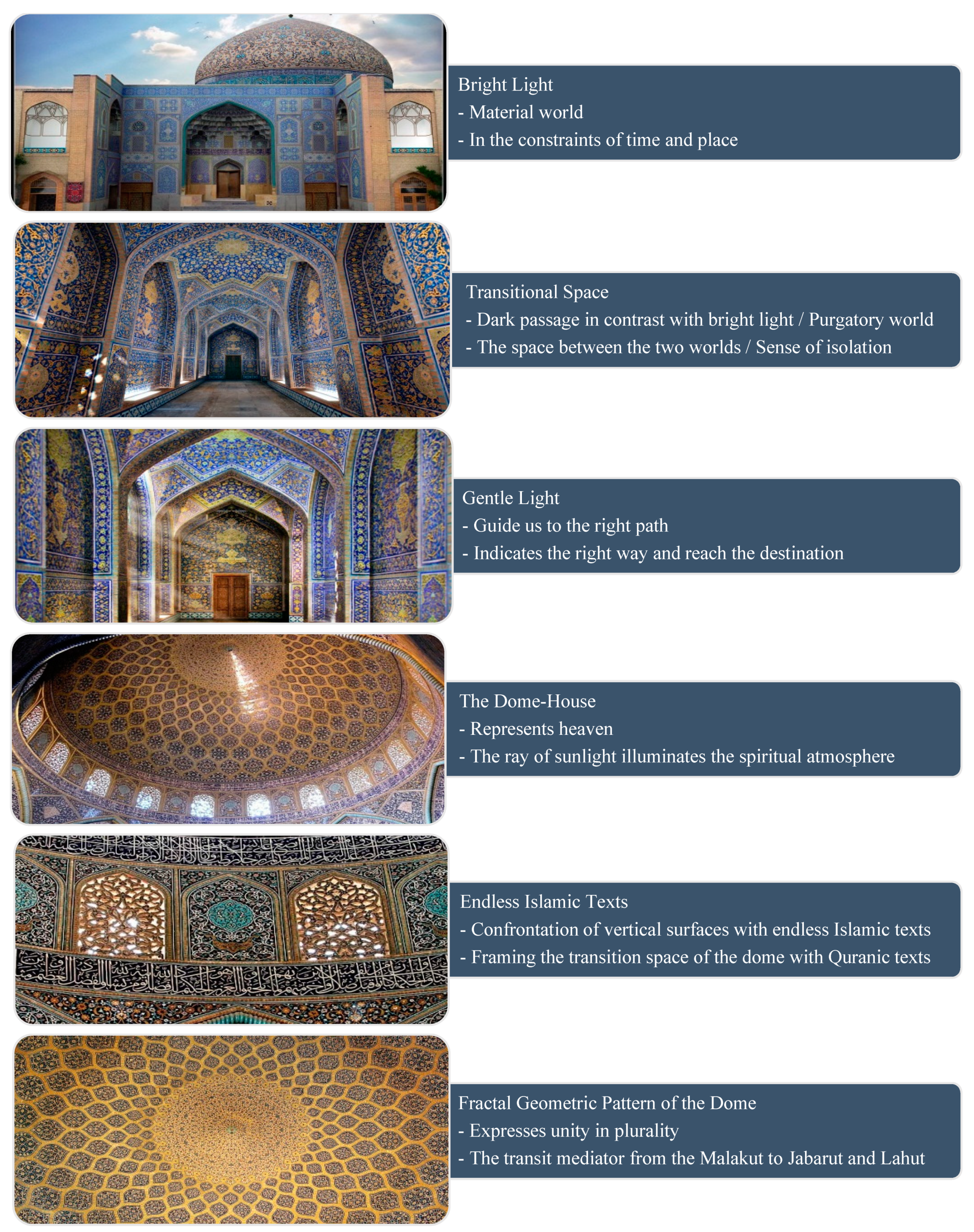
| Quotations | |
|---|---|
| 1 | Lovers don’t finally meet somewhere. They’re in each other all along. |
| 2 | There are a thousand ways to kneel and kiss the ground; there are a thousand ways to go home again. |
| 3 | This place is a dream. Only a sleeper considers it real. Then death comes like dawn, and you wake up laughing at what you thought was your grief. |
| 4 | Would you become a pilgrim on the road of love? The first condition is that you make yourself humble as dust and ashes. |
| 5 | If the foot of the trees were not tied to earth, they would be pursuing me. For I have blossomed so much, I am the envy of the gardens. |
| 6 | Why do you stay in prison, when the door is so wide open? |
| 7 | Everything that is made beautiful and fair and lovely is made for the eye of one who sees. |
| 8 | I know you’re tired but come, this is the way. |
| 9 | The wound is the place where the light enters you. |
| 10 | When the world pushes you to your knees, you’re in the perfect position to pray. |
| 11 | Be empty of worrying. Think of who created thought. |
| 12 | Don’t you know yet? It is your light that lights the world. |
| 13 | Love is the bridge between you and everything. |
| 14 | Seek the wisdom that will untie your knot. Seek the path that demands your whole being. |
| 15 | It’s your road, and yours alone, others may walk it with you, but no one can walk it for you. |
| 16 | Why do you stay in prison when the door is so wide open. |
| 17 | As you start to walk on the way, the way appears. |
| 18 | If light is in your heart, you will find your way home. |
| 19 | There’s a field somewhere beyond all doubt and wrong doing. I’ll meet you there. |
| 20 | Become the sky. Take an axe to the prison wall. Escape. |
| 21 | The wealth within you, your essence, is your kingdom. |
| 22 | Wherever you stand, be the soul of that place. |
| 23 | Let us carve gems out of our stony hearts and let them light our path to love. |
| 24 | Whoever has heart’s doors wide open, could see the sun itself in every atom. |
| 25 | You are not one you are a thousand. Just light your lantern. |
| 26 | Be a lamp, or a lifeboat, or a ladder. Help someone’s soul heal. Walk out of your house like a shepherd. |
| 27 | The garden of the world has no limit except in your mind. |
| 28 | When I am silent, I fall into the place where everything is music. |
| 29 | Beauty surrounds us, but usually, we need to be walking in a garden to know it. |
| 30 | Whatever purifies you is the right path, I will not try to define it. |
| The material world (Nasut) | The material world is the universe we live in now which is bound by time and place. |
| The heavenly world (Malakut) | The heavenly world is beyond the material world like the world of purgatory or the world of angels. |
| The abstract world (Jabarut) | A world which is an abstract of material, form, and time, a world of divine power and greatness, dominance with gratification. |
| The divinity world (Lahut) | It is the most holy essence of God that is inconceivable. |
Publisher’s Note: MDPI stays neutral with regard to jurisdictional claims in published maps and institutional affiliations. |
© 2022 by the authors. Licensee MDPI, Basel, Switzerland. This article is an open access article distributed under the terms and conditions of the Creative Commons Attribution (CC BY) license (https://creativecommons.org/licenses/by/4.0/).
Share and Cite
Askarizad, R.; He, J.; Ardejani, R.S. Semiology of Art and Mysticism in Persian Architecture According to Rumi’s Mystical Opinions (Case Study: Sheikh Lotf-Allah Mosque, Iran). Religions 2022, 13, 1059. https://doi.org/10.3390/rel13111059
Askarizad R, He J, Ardejani RS. Semiology of Art and Mysticism in Persian Architecture According to Rumi’s Mystical Opinions (Case Study: Sheikh Lotf-Allah Mosque, Iran). Religions. 2022; 13(11):1059. https://doi.org/10.3390/rel13111059
Chicago/Turabian StyleAskarizad, Reza, Jinliao He, and Roomina Soleymani Ardejani. 2022. "Semiology of Art and Mysticism in Persian Architecture According to Rumi’s Mystical Opinions (Case Study: Sheikh Lotf-Allah Mosque, Iran)" Religions 13, no. 11: 1059. https://doi.org/10.3390/rel13111059
APA StyleAskarizad, R., He, J., & Ardejani, R. S. (2022). Semiology of Art and Mysticism in Persian Architecture According to Rumi’s Mystical Opinions (Case Study: Sheikh Lotf-Allah Mosque, Iran). Religions, 13(11), 1059. https://doi.org/10.3390/rel13111059








